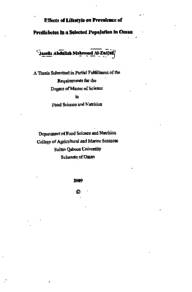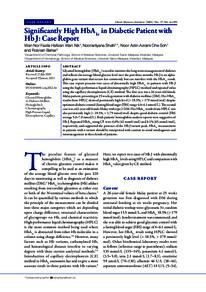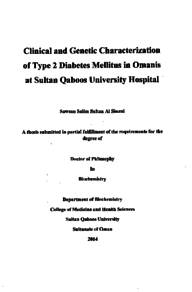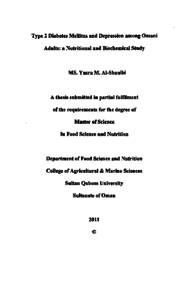وثيقة
Effects of lifestyle on prevalence of prediabetes in a selected population in Oman
الناشر
Sultan Qaboos University
ميلادي
2009
اللغة
الأنجليزية
الموضوع
الملخص الإنجليزي
Diabetes mellitus (DM) is a growing worldwide health problem. It is recognized as a group of heterogeneous disorders with the common elements of hyperglycaemia and glucose intolerance. Prevention of diabetes is based on a better understanding of pathophysiology of the disease and early identification of the associated risk factors in apparently healthy individuals. The present study aimed to investigate the prevalence of prediabetes in a selected population of wilayatt Bidbid and to examine association of lifestyle factors such as sociodemographic, diet, obesity, and physical activity with the risk of prediabetes. Community based cross-sectional study was conducted to identify individuals with prediabetes as per WHO 1999 diagnostic criteria. Anthropometric measurements, biochemical data including plasma lipid profile, fasting and oral glucose tolerance tests were performed. A validated comprehensive questionnaire on sociodemograhic status, dietary intake, and physical activity assessment was conducted as well. Descriptive analysis was used to determine prediabetes prevalence, Logistic regression was applied to predict risk factors of prediabetes by obtaining odds ratio (OR) and their 95% confidence interval (CI). Out of 1219 participants, 19.5% were found to be prediabetics and 6.2% were newly diagnosed diabetics. 10.7% of prediabetic subjects were diagnosed as impaired glucose tolerant (IGT), 5.7% as impaired fasting glucose (IFG), and 3.2% were with both IFG and IGT. Sociodemographic determinants such as age (OR= 6.8, 95% CI = 3.1-15.0) and educational status were significantly associated with elevated risk of prediabetes. Individuals of 60 years old or more were 6.8 times at higher risk of developing prediabetes than those of 18 to 19 years (OR= 6.8, 95% CI = 3.1-15.0). The risk of being prediabetic was 3.4 times higher among illiterates compared to university graduates (OR = 3.4, 95% CI = 1.5 -7.6). Age and gender adjusted logistic regression revealed that obesity (BMI > 30 kg/m) was associated with increased risk of prediabetes (OR=2.6, 95% CI = 1.8-3.8). The risk of being prediabetic elevated among subjects with large waist circumference (WC) by 2.3 times than those with normal WC (OR = 2.3, 95% CI = 1.6-3.3). Subjects who were with high waist to hip ratio (WHR) increased their risk of prediabetes by 2.1 times compared to those with normal WHR (OR = 2.1, 95% CI= 1.5-2.9). However, no statistically significant association was obtained between dietary intake of various food groups and risk of prediabetes. Total leisure time exercise metabolic equivalence task per week (MET/week) contributed to the lower risk of prediabetes only among the individuals in the highest quartile group (OR = 0.5, 95% CI = 0.3 0.9), whereas walking pace and Total MET/week spent on walking were insignificantly associated with the risk. Individuals of 40 years old or more, lower educational status, overweight or obese especially of large waist circumference and waist hip ratio, and characterized with abnormal lipid profile, irrespective of their dietary intake, were at higher risk of developing prediabetes. In conclusion, illiteracy, obesity, abdominal obesity, sedentary lifestyle appears to be markedly associated with the risk of prediabetes. Thus, a community-based multiple strategies are required to combat the increasing rate of prediabetes and its subsequent end stage of DM.
الوصف
Thesis
المجموعة
URL المصدر
الملخص العربي
يعتبر داء السكري من المشاكل الصحية الأكثر انتشار في العالم، وهو مجموعة من الإضطرابات الأيضية المؤدية إلى زيادة السكر في الدم. و تعتمد الوقاية من الإصابة بداء السكري على الفهم العلمي السلوكية المرض من الناحية الفيزيولوجية والتشخيص المبكر للعوامل المرتبطة به. تهدف هذه الدراسة إلى بحث انتشار احتمالية الإصابة بداء السكري في ولاية بدبد و استكشاف مدى ارتباط أنماط الحياة مثل الخصائص السكانية الأجتماعية، الحمية، السمنة، والنشاط البدني بمخاطر احتمالية الإصابة بالمرض. تم إجراء دراسة انتقائية عشوائية للمجتمع لتحديد الأفراد الذين يحتمل إصابتهم بالداء وفقا لمعايير التشخيص المعتمدة من قبل منظمة الصحة العالمية. وقد تم أجراء قياسات الجسم وكذلك فحوصات الدم اللازمة لسكر الجلوكوز و الدهون. بالإضافة إلى إجراء استبيان شامل عن الحالة السكانية الاجتماعية، الأغذية المستهلكة وتقييم النشاط البدني، تم تطبيق مبدا الارتداد اللوجستي التنبؤ عوامل الخطورة لأحتمالية الإصابة بالمرض عن طريق معرفة نسبة الأرجحية (OR) و فترة الثقة (CI) 95 %. وجد أن 19 . 5 % من 1219 مشترك تم تشخيصهم باحتمالية الإصابة بالسكري، و 6 . 2 % مصابين بداء السكري. أوضحت الدراسة إن العوامل الاجتماعية الديموغرافية مثل العمر و الحالة التعليمية كانا مرتبطان إحصائيا بزيادة احتمالية الإصابة بالسكري، حيث كان الأفراد في عمر الستين فما فوق أكثر عرضة لاحتمالية الإصابة بالمرض و كانت النسبة هي الأعلى بين الأميين. و كما أن من يعانون من السمنة ( BMI > 30 kg / m2 ) ولديهم محيط وسط (WC) و نسبة توزيع الشحوم في الجسم (WHR) كبير هم الأكثر عرضة لاحتمالية الإصابة بالمرض. أوضحت الدراسة أنه لا يوجد ارتباط إحصائي معنوي بين نوعية و كمية تناول الأغذية المستهلكة و احتمالية الإصابة بالمرض. أثبت البحث أن ممارسة الأنشطة الرياضية لها أهميتها في الحد من احتمالية الإصابة بداء السكري. و كانت خطورة الإصابة باحتمالية المرض هو الأعلى لدى الأفراد في عمر 40 سنة فما فوق، و ممن هم في مستوى تعليمي منخفض و ممن يعانون من السمنة و إختلال كبير في نسبة توزيع الشحوم في الجسم (WHR) و يمتازون بمعدلات دهون غير طبيعية في الدم، بغض النظر عن نوعية و كمية الغذاء المستهلك. وفي الخلاصة فأنه يمكن الاستنتاج بأن أنماط الحياة المتميزة بالأمية و بقلة النشاط البدني و التي تؤدي غالبا إلى السمنة والمعدلات غير الطبيعية لدهون الدم ترتبط بمخاطر احتمالية الإصابة بداء السكري، فإنه ينصح باعتماد خطط استراتيجية لتلافي استفحال هذا المرض.
قالب العنصر
الرسائل والأطروحات الجامعية







